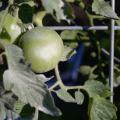Onions
Onions

Onions are grown for green-topped salad onions and dry bulb onions. Select a loose, fertile soil and start with transplants, small dry bulbs (sets), or seeds. Set out transplants in late winter and early spring, depending on location, and use for both salad and bulb onions. Onion sets planted in early spring also produce salad onions and bulbs. Fall-planted sets produce fall salad onions and when overwintered, produce spring salad onions and bulbs.
Onion seeds are normally planted in fall (September to October) for the production of transplants, but few gardeners go to the trouble of raising their own onion plants.
Separate onion sets into two sizes—smaller than a dime and larger than a dime—before planting. The small sets planted in spring make bulb onions, and planted in fall, may survive the winter to make bulb onions. Large sets planted in spring or fall generally flower and should be used for green salad onions since onion plants that flower do not mature into good dry bulbs.
Space sets and transplants for bulb onions 4 to 6 inches apart in the garden row. Onion plants have shallow roots and are subject to injury from dry soils. Side-dress with a nitrogen fertilizer once or twice to encourage strong and vigorous growth.
As onion bulbs begin to mature, the tops yellow and fall over. Lifting the bulbs gently with a turning fork to break some of the roots hastens maturity. Do not bend over the tops to hasten maturity. This practice reduces bulb size and opens the onions to neck rot.
The onion varieties grown for bulbs in the South do not make strong-flavored, hard-storage type bulbs. The soft, sweet Southern onions keep for several weeks, but plan to use them rapidly.
Varieties
- Crystal Wax—white skin and flesh; standard variety; flat, medium-sized bulb; soft, mild flesh; also used for green salad onions.
- Granex 33—Vidalia type onion; hybrid; thick, flat globe shape; yellow skin; fair storage quality; mild, sweet flavor; susceptible to pink root.
- Granex 429—yellow skin; deeper shape than Granex 33 and several days later maturing; mild, sweet flavor.
- Texas Grano-1015 Y—yellow skin; globe shape; sweet and mild; resistant to pink root.
Publications
News
Mississippi’s ideal growing season means gardens can yield a lot of produce, but this usually comes with the help of pesticides to combat insects and diseases.
It is vital that home gardeners know how much time must elapse between application of the product and when the food is harvested, a time frame known as the pre-harvest interval, or PHI.
Home canning is an economical way to preserve the bounty of your garden. This Q&A may answer some questions for you, whether you’re new to canning or you’ve been canning for years.
Did you know the Mississippi State University Extension Service has a laboratory that is designated to diagnose plant diseases and nematodes? Yes, it does! Learn how the Mississippi State University Extension Service Plant Diagnostic Laboratory and its scientists protect the crops that provide our food and fiber along with other home and garden crops.




